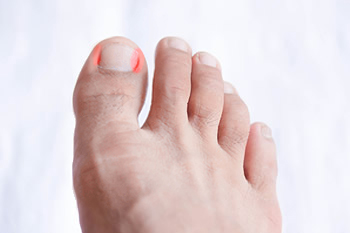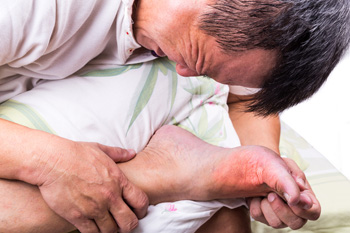Items filtered by date: November 2022
What Is the Proper Way of Cutting Toenails?

An ingrown toenail occurs when the nail grows into the skin surrounding it. Oftentimes this happens from cutting toenails too short and tapering nail edges. Ingrown toenails can also occur from wearing shoes or socks that are too tight or short or from a trauma, such as stubbing the toe. It can look bad and feel painful. It can also turn into an infection. The correct way of trimming toenails is to cut them straight across with no curvature. If you have cut the nails properly, you should be able to get a fingernail under the sides and end of the nail. If you have an ingrown toenail, you can try soaking the toe in warm water with Epsom salts, which may help soften the skin surrounding the toenail and reduce inflammation and pain. Consider wearing sandals or shoes with a lot of room in the toe box until the nail has healed. If the toenail looks infected or if it is not healing well, see a podiatrist who can suggest further treatments.
Ingrown toenails may initially present themselves as a minor discomfort, but they may progress into an infection in the skin without proper treatment. For more information about ingrown toenails, contact the foot specialists of Table Mountain Foot and Ankle. Our doctors can provide the care you need to keep you pain-free and on your feet.
Ingrown Toenails
Ingrown toenails are caused when the corner or side of a toenail grows into the soft flesh surrounding it. They often result in redness, swelling, pain, and in some cases, infection. This condition typically affects the big toe and may recur if it is not treated properly.
Causes
- Improper toenail trimming
- Genetics
- Improper shoe fitting
- Injury from pedicures or nail picking
- Abnormal gait
- Poor hygiene
You are more likely to develop an ingrown toenail if you are obese, have diabetes, arthritis, or have any fungal infection in your nails. Additionally, people who have foot or toe deformities are at a higher risk of developing an ingrown toenail.
Symptoms
Some symptoms of ingrown toenails are redness, swelling, and pain. In rare cases, there may be a yellowish drainage coming from the nail.
Treatment
Ignoring an ingrown toenail can have serious complications. Infections of the nail border can progress to a deeper soft-tissue infection, which can then turn into a bone infection. You should always speak with your podiatrist if you suspect you have an ingrown toenail, especially if you have diabetes or poor circulation.
If you have any questions, please feel free to contact our office located in Wheat Ridge, CO . We offer the newest diagnostic and treatment technologies for all your foot care needs.
Do You Suffer From Painful Feet?
Treatment for Rheumatoid Arthritis

Chronic pain and swelling in the joints of the feet is often an indicator of rheumatoid arthritis or RA. The immune system gets mixed signals and attacks the tissue that lines your joints. In addition to pain, rheumatoid arthritis brings stiffness and sometimes a flu-like feeling of achiness. Though there is no known cure for rheumatoid arthritis, it can be treated and managed to reduce pain and allow you to have an active life. It is recommended that you keep active by doing some form of exercise several times a week. Non-steroidal anti-inflammatory medication is often prescribed for RA, along with increased attention to what you are eating. Certain foods add to inflammation and others, such as those rich in omega-3, help to prevent it. If you have rheumatoid arthritis that affects your feet, please consult a podiatrist for treatment options.
Because RA affects more than just your joints, including the joints in your feet and ankles, it is important to seek early diagnosis from your podiatrist if you feel like the pain in your feet might be caused by RA. For more information, contact the foot specialists of Table Mountain Foot and Ankle. Our doctors will assist you with all of your podiatric concerns.
What Is Rheumatoid Arthritis?
Rheumatoid Arthritis (RA) is an autoimmune disorder in which the body’s own immune system attacks the membranes surrounding the joints. Inflammation of the lining and eventually the destruction of the joint’s cartilage and bone occur, causing severe pain and immobility.
Rheumatoid Arthritis of the Feet
Although RA usually attacks multiple bones and joints throughout the entire body, almost 90 percent of cases result in pain in the foot or ankle area.
Symptoms
- Swelling and pain in the feet
- Stiffness in the feet
- Pain on the ball or sole of feet
- Joint shift and deformation
Diagnosis
Quick diagnosis of RA in the feet is important so that the podiatrist can treat the area effectively. Your doctor will ask you about your medical history, occupation, and lifestyle to determine the origin of the condition. Rheumatoid Factor tests help to determine if someone is affected by the disease.
If you have any questions please feel free to contact our office located in Wheat Ridge, CO . We offer the newest diagnostic and treatment technologies for all your foot and ankle needs.
Causes and Risks of Gout

Gout is a form of arthritis that results in joint pain and swelling in the joints and frequently attacks the big toe. Gout is caused by a buildup of uric acid in the blood that forms crystals in the joints. If ignored, gout can result in serious health issues affecting the kidneys and may permanently damage the joints. The main cause of high uric acid in the blood is that it is not being flushed out properly. Genetics is thought to be the number one contributor to this. Other factors include underlying health issues and side effects of certain medication. You may be at higher risk of developing gout if you are overweight, have high blood pressure, and eat foods rich in purines. Men over 40 and women in menopause are also at greater risk of developing gout. If you have two or more gout attacks in your toe within a year, it is a good idea to contact a podiatrist. A number of medical treatments are available to keep the uric acid levels down. Changes to diet and weight reduction may also be recommended.
Gout is a painful condition that can be treated. If you are seeking treatment, contact the foot specialists from Table Mountain Foot and Ankle. Our doctors will treat your foot and ankle needs.
What Is Gout?
Gout is a form of arthritis that is characterized by sudden, severe attacks of pain, redness, and tenderness in the joints. The condition usually affects the joint at the base of the big toe. A gout attack can occur at any random time, such as the middle of the night while you are asleep.
Symptoms
- Intense Joint Pain - Usually around the large joint of your big toe, and it most severe within the first four to twelve hours
- Lingering Discomfort - Joint discomfort may last from a few days to a few weeks
- Inflammation and Redness -Affected joints may become swollen, tender, warm and red
- Limited Range of Motion - May experience a decrease in joint mobility
Risk Factors
- Genetics - If family members have gout, you’re more likely to have it
- Medications - Diuretic medications can raise uric acid levels
- Gender/Age - Gout is more common in men until the age of 60. It is believed that estrogen protects women until that point
- Diet - Eating red meat and shellfish increases your risk
- Alcohol - Having more than two alcoholic drinks per day increases your risk
- Obesity - Obese people are at a higher risk for gout
Prior to visiting your podiatrist to receive treatment for gout, there are a few things you should do beforehand. If you have gout you should write down your symptoms--including when they started and how often you experience them, important medical information you may have, and any questions you may have. Writing down these three things will help your podiatrist in assessing your specific situation so that he or she may provide the best route of treatment for you.
If you have any questions, please feel free to contact our office located in Wheat Ridge, CO . We offer the newest diagnostic and treatment technologies for all your foot care needs.
Bunions Are a Common Foot Condition

The probability is high for developing a bunion. Research has shown that one-third of Americans will eventually have bunions, and it is easier to treat in the beginning stages. It is defined as a bony growth that gradually forms on the side of the big toe, and can cause discomfort while walking. It happens from genetic reasons, or, most commonly from wearing shoes that do not have enough room for the toes to move freely in. Calluses and corns may form on untreated bunions, and larger shoes may need to be purchased that can accommodate the bunion. Relief may be found when the correct width of shoes are worn, and high heels may have to be eliminated from frequent wearing. Bunions will typically not diminish on their own, but they may be easier to live with when the right shoes are worn. If the bunion is making daily activities difficult to accomplish, surgery may be a necessary option for permanent relief. It is strongly suggested that you consult a podiatrist who can provide you with the answers you may be seeking.
If you are suffering from bunions, contact the foot specialists of Table Mountain Foot and Ankle. Our doctors can provide the care you need to keep you pain-free and on your feet.
What Is a Bunion?
A bunion is formed of swollen tissue or an enlargement of boney growth, usually located at the base joint of the toe that connects to the foot. The swelling occurs due to the bones in the big toe shifting inward, which impacts the other toes of the foot. This causes the area around the base of the big toe to become inflamed and painful.
Why Do Bunions Form?
Genetics – Susceptibility to bunions are often hereditary
Stress on the feet – Poorly fitted and uncomfortable footwear that places stress on feet, such as heels, can worsen existing bunions
How Are Bunions Diagnosed?
Doctors often perform two tests – blood tests and x-rays – when trying to diagnose bunions, especially in the early stages of development. Blood tests help determine if the foot pain is being caused by something else, such as arthritis, while x-rays provide a clear picture of your bone structure to your doctor.
How Are Bunions Treated?
- Refrain from wearing heels or similar shoes that cause discomfort
- Select wider shoes that can provide more comfort and reduce pain
- Anti-inflammatory and pain management drugs
- Orthotics or foot inserts
- Surgery
If you have any questions, please feel free to contact our office located in Wheat Ridge, CO . We offer the newest diagnostic and treatment technologies for all your foot care needs.

